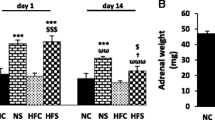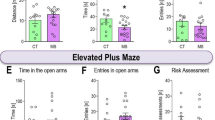Abstract
Purpose
Chronic glucocorticoid release during the stress response has been proposed to initiate certain damages, which in turn produce metabolic disorders. The present study is the first work to test whether maternal separation (MS) would impact the metabolic alterations associated with pancreatic oxidative and inflammatory damages under chronic exposure to social defeat stress (CSDS) in adulthood.
Methods
During the first 2 weeks of life, male Wistar rats were exposed to MS or left undisturbed with their mothers (Std). Starting on postnatal day 50, the animals of each group were either left undisturbed in the standard group housing (Con) or underwent CSDS for 3 weeks. Thus, there were 4 groups (n = 7/group): Std-Con, Ms-Con, Std-CSDS, MS-CSDS. Each animal was weighed and then decapitated so that we could collect trunk blood for assessment of fasting plasma corticosterone, insulin, glucose, lipid profile, and insulin resistance. Plasma and pancreatic catalase activity, reduced glutathione (GSH), malondialdehyde levels and pancreatic interleukin-1 beta (IL-1β) content were also measured.
Results
MS-CSDS animals showed elevated plasma corticosterone and insulin levels (P < 0.01) along with insulin resistance (P < 0.05). According to one-way ANOVA results, chronic exposure to early or adult life adversity decreased body weight (P < 0.0001), Catalase activity and GSH levels (P < 0.0001) and increased malondialdehyde level (P = 0.0006) in plasma. Pancreatic MDA and IL-1β contents elevated just in MS-CSDS rats (P < 0.05).
Conclusion
Maternal separation shapes vulnerability to develop corticosterone hypersecretion, insulin resistance, pancreatic oxidative, and inflammatory damages associated with chronic exposure to later social challenges, which could potentially trigger metabolic disorders.



Similar content being viewed by others
References
Coccurello R, D’Amato FR, Moles A. Chronic social stress, hedonism and vulnerability to obesity: lessons from rodents. Neurosci Biobehav Rev. 2009;33(4):537–50.
Heim C, Binder EB. Current research trends in early life stress and depression: review of human studies on sensitive periods, gene–environment interactions, and epigenetics. Exp Neurol. 2012;233(1):102–11.
Champagne DL, Ronald de Kloet E, Joëls M. Fundamental aspects of the impact of glucocorticoids on the (immature) brain. Semin Fetal Neonatal Med. 2009;14(3):136–42.
Franklin TB, Saab BJ, Mansuy IM. Neural mechanisms of stress resilience and vulnerability. Neuron. 2012;75(5):747–61. https://doi.org/10.1016/j.neuron.2012.08.016.
Rosmond R. Role of stress in the pathogenesis of the metabolic syndrome. Psychoneuroendocrinology. 2005;30(1):1–10.
Krishnan V, Han M-H, Graham DL, Berton O, Renthal W, Russo SJ, LaPlant Q, Graham A, Lutter M, Lagace DC, et al. Molecular adaptations underlying susceptibility and resistance to social defeat in brain reward regions. Cell. 2007;131(2):391–404.
Teague CR, Dhabhar FS, Barton RH, Beckwith-Hall B, Powell J, Cobain M, Singer B, McEwen BS, Lindon JC, Nicholson JK, et al. Metabonomic studies on the physiological effects of acute and chronic psychological stress in Sprague–Dawley rats. J Proteome Res. 2007;6(6):2080–93.
McEwen BS, Wingfield JC. The concept of allostasis in biology and biomedicine. Horm Behav. 2003;43(1):2–15.
Spiers JG, Chen H-JC, Sernia C, Lavidis NA. Activation of the hypothalamic-pituitary-adrenal stress axis induces cellular oxidative stress. Front Neurosci. 2015;8:456.
Roldan M, Rose AJ, Herzig S. Glucocorticoid hormones and energy homeostasis. Horm Mol Biol Clin Investig. 2014;19(2):117–28.
Ježek P, Jabůrek M, Plecitá-Hlavatá L. Contribution of oxidative stress and impaired biogenesis of pancreatic β-cells to type 2 diabetes. Antioxidants Redox Signal. 2019;31(10):722–51.
Keane KN, Cruzat VF, Carlessi R, De Bittencourt PIH, Newsholme P. Molecular events linking oxidative stress and inflammation to insulin resistance and β-cell dysfunction. Oxid Med Cell Longev. 2015;2015:181643.
Newsholme P, Rebelato E, Abdulkader F, Krause M, Carpinelli A, Curi R. Reactive oxygen and nitrogen species generation, antioxidant defenses, and β-cell function: a critical role for amino acids. J Endocrinol. 2012;214(1):11–20.
Gehrmann W, Elsner M, Lenzen S. Role of metabolically generated reactive oxygen species for lipotoxicity in pancreatic β-cells. Diabetes Obes Metab. 2010;12:149–58.
Siddiqui A, Desai NG, Sharma SB, Aslam M, Sinha UK, Madhu SV. Association of oxidative stress and inflammatory markers with chronic stress in patients with newly diagnosed type 2 diabetes. Diabetes Metab Res Rev. 2019;35(5):e3147.
Azevedo-Martins AK, Lortz S, Lenzen S, Curi R, Eizirik DL, Tiedge M. Improvement of the mitochondrial antioxidant defense status prevents cytokine-induced nuclear factor-κB activation in insulin-producing cells. Diabetes. 2003;52(1):93–101.
Cnop M, Abdulkarim B, Bottu G, Cunha DA, Igoillo-Esteve M, Masini M, Turatsinze J-V, Griebel T, Villate O, Santin I, et al. RNA sequencing identifies dysregulation of the human pancreatic islet transcriptome by the saturated fatty acid palmitate. Diabetes. 2014;63(6):1978–93.
Berchtold LA, Prause M, Størling J, Mandrup-Poulsen T. Cytokines and pancreatic β-cell apoptosis. Adv Clin Chem. 2016;75:99–158.
Iio W, Matsukawa N, Tsukahara T, Kohari D, Toyoda A. Effects of chronic social defeat stress on MAP kinase cascade. Neurosci Lett. 2011;504(3):281–4.
Ghasemi A, Tohidi M, Derakhshan A, Hasheminia M, Azizi F, Hadaegh F. Cut-off points of homeostasis model assessment of insulin resistance, beta-cell function, and fasting serum insulin to identify future type 2 diabetes: Tehran Lipid and Glucose Study. Acta Diabetol. 2015;52(5):905–15.
Bradford MM. A rapid and sensitive method for the quantitation of microgram quantities of protein utilizing the principle of protein-dye binding. Anal Biochem. 1976;72(1–2):248–54.
Goth L. A simple method for determination of serum catalase activity and revision of reference range. Clin Chim acta. 1991;196(2–3):143–51.
Ellman GL. Tissue sulfhydryl groups. Arch Biochem Biophys. 1959;82(1):70–7.
Kamper EF, Chatzigeorgiou A, Tsimpoukidi O, Kamper M, Dalla C, Pitychoutis PM, Papadopoulou-Daifoti Z. Sex differences in oxidant/antioxidant balance under a chronic mild stress regime. Physiol Behav. 2009;98(1–2):215–22.
Vargas J, Junco M, Gomez C, Lajud N. Early life stress increases metabolic risk, HPA axis reactivity, and depressive-like behavior when combined with postweaning social isolation in rats. PLoS ONE. 2016;11(9):e0162665. https://doi.org/10.1371/journal.pone.0162665.
Ladd CO, Huot RL, Thrivikraman KV, Nemeroff CB, Plotsky PM. Long-term adaptations in glucocorticoid receptor and mineralocorticoid receptor mRNA and negative feedback on the hypothalamo-pituitary-adrenal axis following neonatal maternal separation. Biol Psychiatry. 2004;55(4):367–75.
Cotella EM, Mestres Lascano I, Franchioni L, Levin GM, Suárez MM. Long-term effects of maternal separation on chronic stress response suppressed by amitriptyline treatment. Stress. 2013;16(4):477–81.
Ladd CO, Thrivikraman KV, Huot RL, Plotsky PM. Differential neuroendocrine responses to chronic variable stress in adult Long Evans rats exposed to handling-maternal separation as neonates. Psychoneuroendocrinology. 2005;30(6):520–33.
Sanchez MM, Ladd CO, Plotsky PM. Early adverse experience as a developmental risk factor for later psychopathology: evidence from rodent and primate models. Dev Psychopathol. 2001;13(3):419–49.
Liu D, Caldji C, Sharma S, Plotsky PM, Meaney MJ. Influence of neonatal rearing conditions on stress-induced adrenocorticotropin responses and norepinepherine release in the hypothalamic paraventricular nucleus. J Neuroendocrinol. 2000;12(1):5–12.
Ladd CO, Huot RL, Thrivikraman KV, Nemeroff CB. Long-term behavioral and neuroendocrine adaptations to adverse early experience. Prog Brain Res. 1998;122(3):2000.
Caldji C, Francis D, Sharma S, Plotsky PM, Meaney MJ. The effects of early rearing environment on the development of GABA A and central benzodiazepine receptor levels and novelty-induced fearfulness in the rat. Neuropsychopharmacology. 2000;22(3):219–29.
Buwalda B, Kole MHP, Veenema AH, Huininga M, de Boer SF, Korte SM, Koolhaas JM. Long-term effects of social stress on brain and behavior: a focus on hippocampal functioning. Neurosci Biobehav Rev. 2005;29(1):83–97.
Tamashiro KLK, Hegeman MA, Nguyen MMN, Melhorn SJ, Ma LY, Woods SC, Sakai RR. Dynamic body weight and body composition changes in response to subordination stress. Physiol Behav. 2007;91(4):440–8.
Zardooz H, Asl SZ, Naseri MG. Effect of chronic psychological stress on insulin release from rat isolated pancreatic islets. Life Sci. 2006;79(1):57–62.
Rabasa C, Dickson SL. Impact of stress on metabolism and energy balance. Curr Opin Behav Sci. 2016;9:71–7.
Rosmond R, Dallman MF, Björntorp P. Stress-related cortisol secretion in men: relationships with abdominal obesity and endocrine, metabolic and hemodynamic abnormalities. J Clin Endocrinol Metab. 1998;83(6):1853–9.
de Oliveira C, Scarabelot VL, de Souza A, de Oliveira CM, Medeiros LF, de Macedo IC, Marques Filho PR, Cioato SG, Caumo W, Torres ILS. Obesity and chronic stress are able to desynchronize the temporal pattern of serum levels of leptin and triglycerides. Peptides. 2014;51:46–53.
Ricart-Jan D, Rodr V, Benavides A, Peinado-Onsurbe J, Llobera M, et al. Immobilization stress alters intermediate metabolism and circulating lipoproteins in the rat. Metab Exp. 2002;51(7):925–31.
Solin AV, Korozin VI, Lyashev YD. Effects of regulatory peptides on the stress-induced changes of lipid metabolism in experimental animals. Bull Exp Biol Med. 2013;155(3):324–6.
Colaianna M, Schiavone S, Zotti M, Tucci P, Morgese MG, Bäckdahl L, Holmdahl R, Krause K-H, Cuomo V, Trabace L. Neuroendocrine profile in a rat model of psychosocial stress: relation to oxidative stress. Antioxid Redox Signal. 2013;18(12):1385–99.
Lesgards J-F, Durand P, Lassarre M, Stocker P, Lesgards G, Lanteaume A, Prost M, Lehucher-Michel M-P. Assessment of lifestyle effects on the overall antioxidant capacity of healthy subjects. Environ Health Perspect. 2002;110(5):479–86.
Nakhaee A, Shahabizadeh F, Erfani M. Protein and lipid oxidative damage in healthy students during and after exam stress. Physiol Behav. 2013;118:118–21.
Kasahara E, Inoue M. Cross-talk between HPA-axis-increased glucocorticoids and mitochondrial stress determines immune responses and clinical manifestations of patients with sepsis. Redox Rep. 2015;20(1):1–10.
Black ACN, Bot M, Scheffer G, Penninx B. The association between three major physiological stress systems and oxidative DNA and lipid damage. Psychoneuroendocrinology. 2017. https://doi.org/10.1016/j.psyneuen.2017.03.003.
Danson EJF, Paterson DJ. Reactive oxygen species and autonomic regulation of cardiac excitability. J Cardiovasc Electrophysiol. 2006;17:S104–12.
Biswas SK. Does the interdependence between oxidative stress and inflammation explain the antioxidant paradox? Oxid Med Cell Longev. 2016;2016:5698931.
Giorgino F, Almahfouz A, Goodyear LJ, Smith RJ, et al. Glucocorticoid regulation of insulin receptor and substrate IRS-1 tyrosine phosphorylation in rat skeletal muscle in vivo. J Clin Invest. 1993;91(5):2020–30.
Dimitriadis G, Leighton B, Parry-Billings M, Sasson S, Young M, Krause U, Bevan S, Piva T, Wegener G, Newsholme EA. Effects of glucocorticoid excess on the sensitivity of glucose transport and metabolism to insulin in rat skeletal muscle. Biochem J. 1997;321(3):707–12.
Piroli GG, Grillo CA, Reznikov LR, Adams S, McEwen BS, Charron MJ, Reagan LP. Corticosterone impairs insulin-stimulated translocation of GLUT4 in the rat hippocampus. Neuroendocrinology. 2007;85(2):71–80.
Esser N, Utzschneider KM, Kahn SE. Early beta cell dysfunction vs insulin hypersecretion as the primary event in the pathogenesis of dysglycaemia. Diabetologia. 2020;63(10):2007–21.
Cnop M, Vidal J, Hull RL, Utzschneider KM, Carr DB, Schraw T, Scherer PE, Boyko EJ, Fujimoto WY, Kahn SE. Progressive loss of β-cell function leads to worsening glucose tolerance in first-degree relatives of subjects with type 2 diabetes. Diabetes Care. 2007;30(3):677–82.
López-López AL, Jaime HB, Villanueva MCE, Padilla MB, Palacios GV, Aguilar FJA. Chronic unpredictable mild stress generates oxidative stress and systemic inflammation in rats. Physiol Behav. 2016;161:15–23.
Kaneto H, Kajimoto Y, Miyagawa J, Matsuoka T, Fujitani Y, Umayahara Y, Hanafusa T, Matsuzawa Y, Yamasaki Y, Hori M. Beneficial effects of antioxidants in diabetes: possible protection of pancreatic beta-cells against glucose toxicity. Diabetes. 1999;48(12):2398–406.
Sokolova M, Sahraoui A, Høyem M, Øgaard J, Lien E, Aukrust P, Yndestad A, Ranheim T, Scholz H. Nlrp3 inflammasome mediates oxidative stress-induced pancreatic islet dysfunction. Am J Physiol Endocrinol Metab. 2018;315(5):E912–23.
Hu C, Ding H, Li Y, Pearson JA, Zhang X, Flavell RA, Wong FS, Wen L. NLRP3 deficiency protects from type 1 diabetes through the regulation of chemotaxis into the pancreatic islets. Proc Natl Acad Sci USA. 2015;112(36):11318–23.
Ralston JC, Lyons CL, Kennedy EB, Kirwan AM, Roche HM. Fatty acids and NLRP3 inflammasome-mediated inflammation in metabolic tissues. Annu Rev Nutr. 2017;37:77–102.
Youm Y-H, Adijiang A, Vandanmagsar B, Burk D, Ravussin A, Dixit VD. Elimination of the NLRP3-ASC inflammasome protects against chronic obesity-induced pancreatic damage. Endocrinology. 2011;152(11):4039–45.
Acknowledgements
This work has been supported financially by the Student Research Committee, Shahid Beheshti University of Medical Sciences.
Author information
Authors and Affiliations
Corresponding author
Ethics declarations
Conflict of interest
The authors declare that they have no conflict of interest.
Additional information
Publisher's note
Springer Nature remains neutral with regard to jurisdictional claims in published maps and institutional affiliations.
Supplementary Information
Below is the link to the electronic supplementary material.
Rights and permissions
About this article
Cite this article
Eskandari, F., Salimi, M., Khodagholi, F. et al. Investigation of the effects of maternal separation on the pancreatic oxidative and inflammatory damages along with metabolic impairment in response to chronic social defeat stress in young adult male rats. J Diabetes Metab Disord 20, 1557–1565 (2021). https://doi.org/10.1007/s40200-021-00902-3
Received:
Accepted:
Published:
Issue Date:
DOI: https://doi.org/10.1007/s40200-021-00902-3




